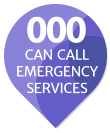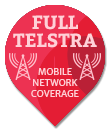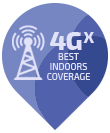Unlimited emergency voice & texts.
Included in your purchase will be a Telstra sim card and unlimited emergency voice and texts for the first year of use. Then it’s just $90 each year from Year 2. Towards the end of Year 1 you’ll be reminded to add a $90 top up to continue to use the full Telstra service for the following year.
This solution allows you to enjoy the widest mobile network coverage in Australia and never have to worry about running out of credit when you need it the most. We’ve worked hard to tailor a custom plan with Telstra that’s affordable and will never let you down.
Advantages
Never worry about running out of credit when you need it the most.
No need to check websites to see how much credit is remaining on your alarm.
You’ll have access to the full Telstra mobile network across Australia.
With this sim solution we can remotely update the software in your device as improvements become available.
No need to supply us with identifying information (EG: drivers licence number) so we can set up your sim card.
No need to even think about cost per minute or cost per text. We’ve got you covered.
Set and forget plan. No hassles.*
*Fair use policy applies. The Live Life mobile alarm is an emergency device and we expect it to be used as such.
Checking and topping up your credit
Before the end of Year 1 we’ll send you reminders to add another $90 for the coming year.
What happens if my prepaid credit runs out?
It won’t! We won’t let it! Your alarm will always work.
Incoming calls to the mobile alarm are free so family and friends can call you on your pendant whenever they like and for as long as they like.
Fair use policy (Telstra managed SIM option)
Yearly recharge of your SIM card
Under this SIM option we allocate the first 12 months of credit to your SIM card (adequate for emergency use). You will need to recharge/renew at 12 months with $90.00 and after each 12 month period. You do not need to check your credit. We will contact you every 12 months with instructions on how to recharge/renew. Your alarm will always be able to call 000 if it is programmed into your alarm even if you don’t renew.
Fair use policy (continued)
Emergency usage policy (’Fair Use’)
The LiveLife Mobile Alarm is designed to be used in an emergency and not like a communication device such as a mobile phone. Your device is meant to be used for help in emergency situations.
Excessive use advice
Under the Telstra Managed SIM option we have allocated a fair and adequate amount of voice and data to your device based on average, emergency usage patterns of thousands of customers. Voice and text usage for every device is monitored by LIVE LIFE ALARMS. Customers using the device’s ‘Side talk button’ or the ‘Location text function’ heavily will be contacted to discuss usage options. We reserve the right to apply further charges for excess use (non-emergency) or discuss the option to move the SIM card into your name if you wish to use the ‘Side talk button’ and the ‘Location text function’ frequently. We also reserve the right to disable these two functions if used excessively in non emergency situations (we would not do this before discussing with you).
Mobile Coverage Disclaimer
The LiveLife Alarm operates in areas where there is available Telstra mobile coverage. The Telstra Mobile Coverage Maps as prepared and updated by Telstra from time to time (please check the Telstra website for updates on coverage areas), are approximate only and provide areas of coverage that should, in most circumstances, and more often than not, offer reasonable mobile coverage. Customers should always be aware that the mobile coverage maps displayed have been created using tools that predict the likely areas of coverage. Live Life Alarms cannot fully guarantee the accuracy of the Mobile Coverage Maps, nor the reliability of the actual mobile coverage. We strongly recommend in circumstances where you intend to travel outside of major cities and/or towns, you refer to the most up to date available mobile coverage on Telstra’s website to determine whether the Live Life Alarm will have available mobile coverage.
Not every location within the identified coverage areas has been individually tested for coverage. This means that while the footprint of coverage outlined on the maps is generally accurate, there maybe specific areas described as being within a coverage area where a customer’s mobile alarm will not necessarily operate at optimal levels or at all.
Coverage could be degraded or non existent in specific locations due to certain physical structures or geographic features or as a result of the device used. Physical structures which may block or inhibit coverage could include basements, lifts, underground car parks, concrete buildings, tunnels and road cuttings. Geographic features which may block or inhibit coverage could include formations such as hills and mountains or even trees.
Bluetooth Disclaimer
Bluetooth is a technology that allows devices to communicate and share data over short distances only without wires. Bluetooth is great for when you are within a relatively short distance from your home such as outside in the backyard, next door at your neighbours or checking your mail box. Bluetooth location provides an accurate and fast solution to your location during an emergency in and around the vicinity of your home only.
Inside the charging station (or Home Beacon) that you received with your alarm is a Bluetooth 5.0 beacon. Your address can be pre-programmed into the Home Beacon by inputting the latitude and longitude co-ordinates of your home and we pair (or connect) the alarm to the Bluetooth Beacon so that the 2 devices are always connected.
Bluetooth (sometimes referred to as BLE by us) also has less power consumption than other location tools, such as GPS and/or wifi. This is one way we are able to get the Live Life Alarm to last as long as 4-5 days between recharges. Our testing indicates that Bluetooth can be relied upon to provide fast positioning when the alarm is within 25 metres of the Bluetooth beacon (Home Beacon). Once the alarm is outside this range, the Bluetooth capability will not work. However, the alarm will attempt to obtain location via GPS or wifi, which are great alternatives.
Wi-Fi Tracking Disclaimer
Wi-Fi location tracking is a geolocation system that uses the entire Wi-Fi infrastructure (phones, tablets, laptops, and routers) as Wi-Fi access points to determine a device’s location. Wi-Fi location tracking is a good system for geolocation whenever the Global Positioning System (GPS) can’t get the job done. For example, GPS can’t always locate your device when you’re indoors, as the signal coming from GPS satellites may be weak or easily blocked. Wifi works by comparing the list of Wi-Fi networks near you to a known list of access points and their locations. In your Live Life Alarm is a wifi chip module and in the case of an emergency, the Live Life Alarm will look for wifi access points to calculate your position. If a wifi location solution can be found faster than using GPS, your wifi location will be reported on Google Maps to your emergency contacts. However, the alarm will always look for a Bluetooth location solution first.
If you find yourself in an area such as a rural setting or out in the country, there is likely to be less wifi access points than in a built up area (such as cities and metropolitan areas). In cases such as these, the Live Life Alarm will more likely resolve to a GPS position for your location.
In the remote possibility a wifi position is reported whilst you are in a rural or country setting, it is possible the accuracy of your location could be less than ideal.
GPS Functions Disclaimer
The LiveLife Mobile Alarm has built-in GPS & GLONAS technology that it uses to fix the location of the pendant with an accuracy range of approximately 2 metres. In order for the GPS functions to operate it requires a line-of-sight connection to satellites in the sky. In some cases, the line-of-sight required to enable and/or operate the GPS may take a few seconds or longer (up to 10 minutes in some cases) to receive the signal and determine the co-ordinates of the device’s location. In cases where there is no available line- of-sight connection to satellites in the sky, the 4GX Live Life Alarm attempts to obtain location using wifi signal, which is a great solution for when the alarm is out of GPS range but in a relatively built up area – cities, surrounding metropolitan areas and large towns.
In the event the pendant cannot receive the GPS signal it will show its wifi position, if available. Underground carparks, lifts, concrete buildings, tunnels and other constructions can block the GPS signal from satellites to the pendant. Live Life Alarms cannot guarantee the device will be able to show its location at all times and the wearer/user must be mindful and aware of the restrictions and/or limitations of GPS.
It is possible that if a wearer of the pendant is in a location where there is no GPS signal, there may also be no available 4GX, 4G or 3G mobile signal meaning the location function of the pendant will not operate till the wearer moves to an unobstructed location. However, the automatic wifi location of the alarm will normally be shown in these circumstances rather then GPS position. The device is designed with redundancy (Bluetooth, GPS and/or wifi location) in mind with respect to obtaining location in the case of an emergency. Additionally, the automatic wifi location of the alarm will normally be shown in circumstances where GPS position is not available.





